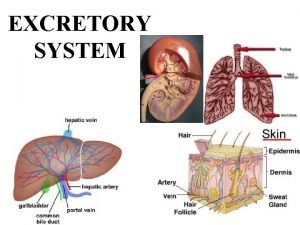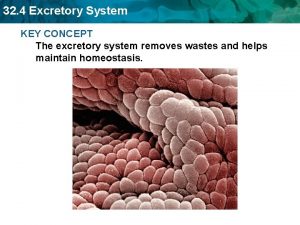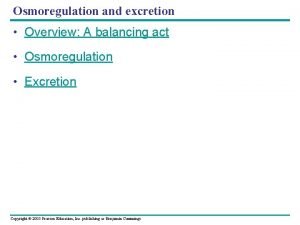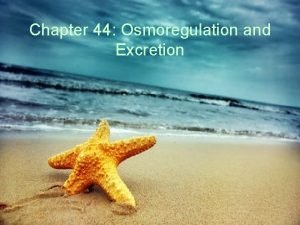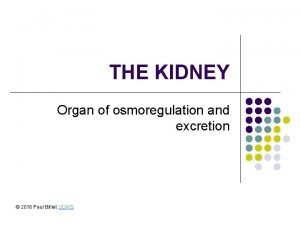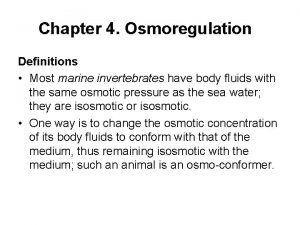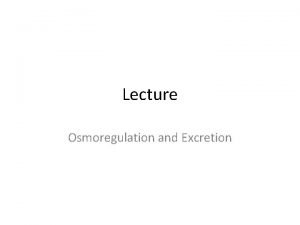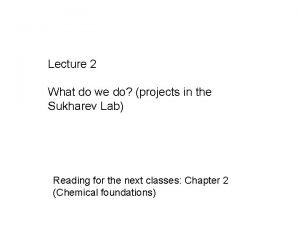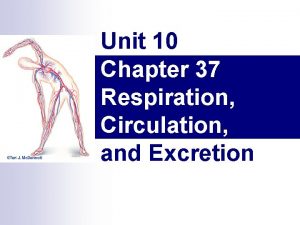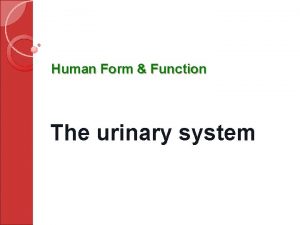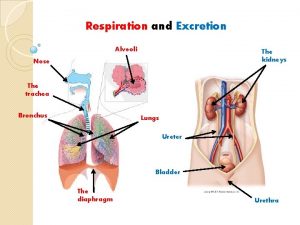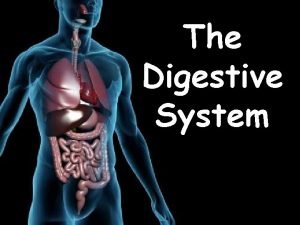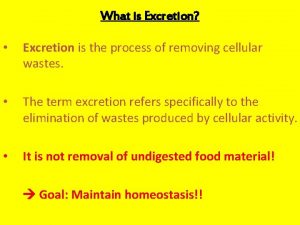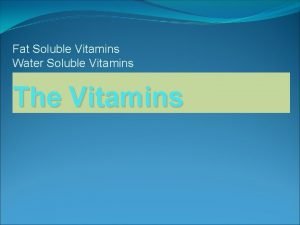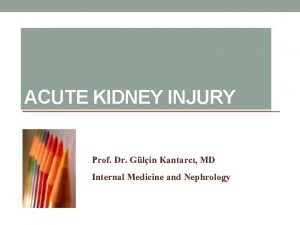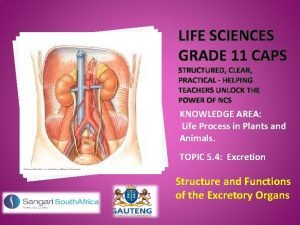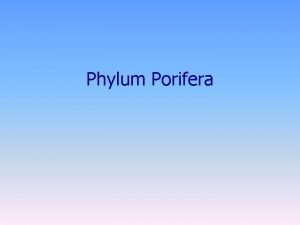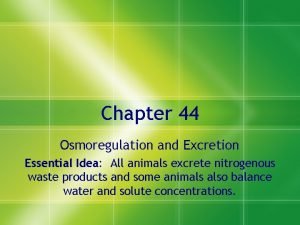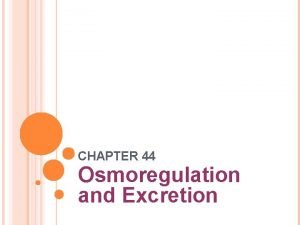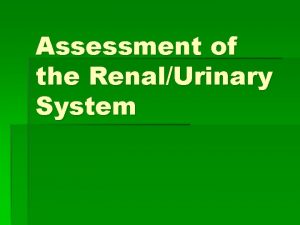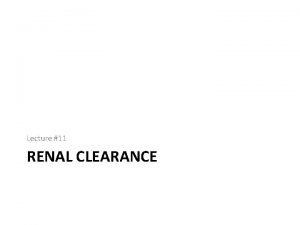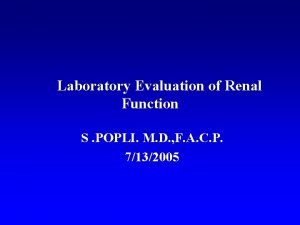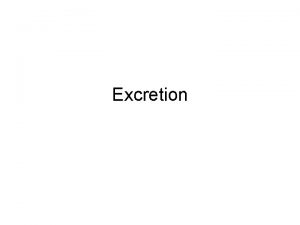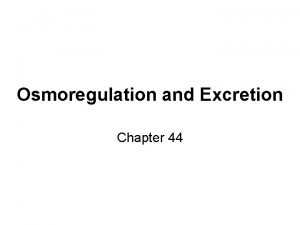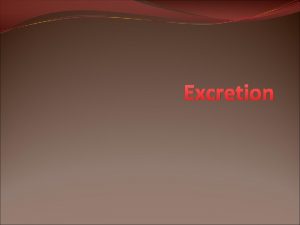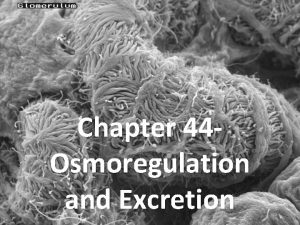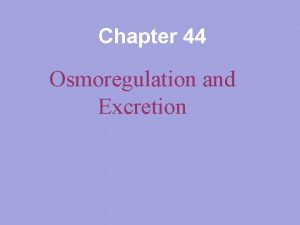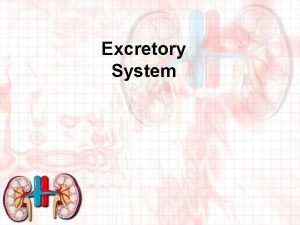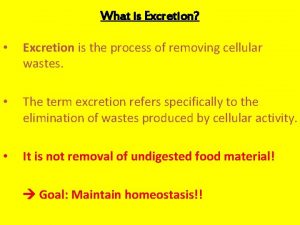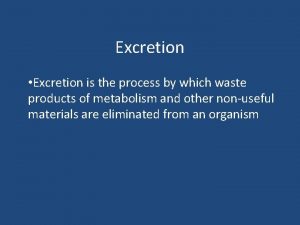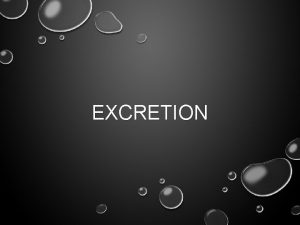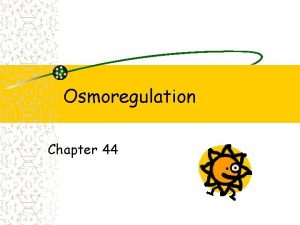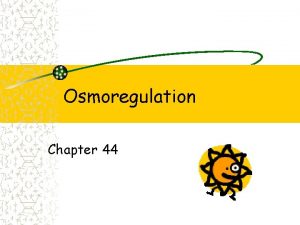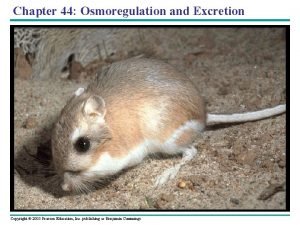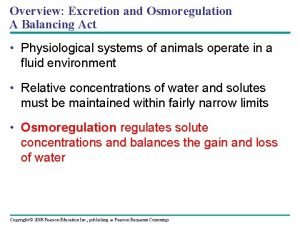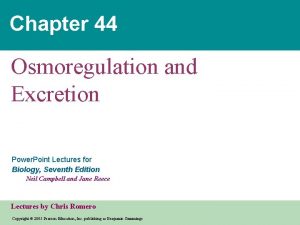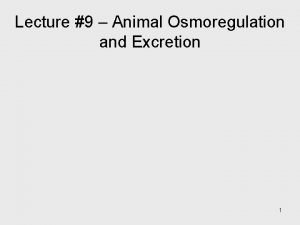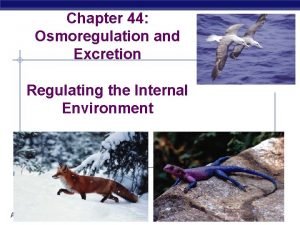Osmoregulation and Excretion CH 44 NOTES Osmoregulation Process



































- Slides: 35

Osmoregulation and Excretion CH 44 NOTES

Osmoregulation Process by which animals control solute concentrations and balance water gain and loss Necessary for systems to function properly Ions must remain at levels to allow muscles, nerves and body cells to work correctly Essential for Homeostasis

Uptake vs Loss of Water uptake and loss must balance If water uptake is excessive, animal cells can swell and burst If water loss is substantial, cells can shrivel and die (plasmolysis) Osmosis – passive process by which water enters and leaves cells Occurs when two solutions differ in osmotic pressure (osmolarity)

Osmolarity Isoosmotic – two solutions with same osmolarity No net movement of water (still moves, but at equal rates) If two solutions differ in osmolarity: Hyperosmotic – solution with more solutes (less water) Hypoosmotic – solution with less solutes (more water) Water flows from a hypoosmotic solution to a hyperosmotic one


Osmoconformer Animal that is isoosmotic with it’s surroundings Marine Animals No tendency to gain or lose water Live in water that has a stable composition so have a constant internal osmolarity

Osmoregulator Controls internal osmolarity independent of its environment Animals can live in non-marine environments (fresh water, land) or marine If they live in a hypoosmotic environment – must be able to get rid of excess water If they live in a hyperosmotic environment – must take in water



Environmental Changes Stenohaline – animals that cannot tolerate changes in external osmolarity (most animals) Euryhaline – animals that can survive large fluctuations in external osmolarity Animals in tidal areas, salmon

Marine Animals Most invert marine animals are osmoconformers Must actively transport solutes to maintain homeostasis Marine vertebrates and some inverts are osmoregulators Ocean dehydrates these animals (lose water) Balance water loss by drinking lots of seawater and pump out salts through active transport (gills or kidneys)

Freshwater Animals Body fluid of freshwater animals is hyperosmotic to the fresh water Water diffuses IN to the cells and salt leaves These animals drink almost NO water Urine is very dilute (lots of water in urine) Salts are replenished by eating Salmon - live in both environments and change their osmoregulation when they move

Temporary Water Some animals live in small ponds that dry out Enter a dormant state called Anhydrobiosis

Terrestrial animals Animals on land always threatened with dehydration Body covering reduces water loss Waxy exoskeleton Shells Dead, keratinized skin Nocturnal – many animals (esp. desert) are active at night to reduce evaporative water loss All must drink and eat moist foods

Energetics of Osmoregulation Costs energy to maintain an osmolarity difference with environment Use active transport to maintain correct solute concentrations needed for homeostasis

Excretion Process that gets rid of nitrogenous metabolites and other waste produces Come from break down of nitrogen containing molecules (like proteins and nucleic acids) that release ammonia – very toxic to cells

Forms of Nitrogenous Waste Ammonia Very toxic to cells Can only be tolerated in very small amounts Animals that excrete ammonia must be surrounded by lots of water Most common in aquatic species Aquatic inverts – release ammonia across body surface Fish – ammonia lost across gills

Forms of Nitrogenous Waste Urea Produced in the liver Made by converting ammonia with carbon dioxide Low toxicity Can be transported in circulatory system and stored safely Animals must expend energy to produce urea Seen in mammals, most amphibs (adults), sharks, some marine bony fish and turtles

Forms of Nitrogenous Waste Uric Acid Relatively non toxic Does not dissolve in water Released as semi-solid paste Very little Water lost Needs even MORE energy to make than urea Seen in insects, land snails, many reptiles and birds


Excretory Processes Urine – Fluid Waste made in four steps 1. Filtration - Body fluid comes in contact with selectively permeable membrane of a transport epithelium. Pressure drives a process where small solutes and water (filtrate) are driven across the epithelium (large molecules stay in body fluid) 2. Reabsorption – Filtrate becomes a waste product after useful molecules are recovered and returned to body fluid by active transport

Excretory Processes 3. Secretion – Non essential solids and wastes, toxins and excess ions are extracted from body fluids into the filtrate 4. Excretion – filtrate (urine) leaves the system and the body

Protonephridia Network of dead-end tubules connected to the outside Flame bulbs are at end of each protnephridium Cilia project into tubules and draw water and solutes from fluid Filtrate moves through tubules and empties into external environment Seen in flatworms (no coelom), rotifers


Metanephridia Open internally to the coelom Each segment has a pair of metanephridia surrounded by capillaries Cilia beat, draw fluid into collecting tubule with bladder Urine moves through tube and solutes are reabsorbed Waste is released to outside Seen in Annelids (earthworms)


Malpighian Tubules Extend from dead end tips immersed in hemolymph to openings in digestive tract No filtration Transport epithelium secretes solutes into tubule Water follows by osmosis Fluid passes to rectum Solutes pumped back into hemolymph Nitrogenous wastes eliminated as dry matter along with feces Seen in insects, terrestrial arthropods


Kidneys Function in osmoregulation and excretion Numerous tubules are highly organized and associated with capillaries Also include ducts that carry urine from tubules out of kidney Seen in vertebrates and some other chordates

Mammal Excretory System Kidney – paired Renal artery – brings blood to kidney Renal vein – drains blood from kidney Receives nearly 25% of blood exiting the heart Ureter – urine exits kidney through this tube Urinary Bladder – storage place for urine Urethra – carries urine to the outside


Kidney Structure Nephron – functional unit with long tubule and ball of capillaries called a Glomerulus Bowman’s capsule - surrounds the glomerulus

Filtration of Blood Occurs as blood pressure forces fluid from blood in the glomerulus into Bowman’s capsule Capillaries are permeable to water and small solutes Impermeable to blood cells and large molecules Filtrate contains salts, glucose, amino acids, vitamins, nitrogenous wastes, and other small molecules

Path of Filtrate From Bowman’s capsule to Proximal tubules Recapture ions, water and valuable nutrients. Ammonia is synthesized and added to filtrate To Descending Loop of Henle Reabsorb water To Ascending Loop of Henle Impermeable to water Contains ion channels Na. Cl is reabsorbed To Distal Tubule Contributes to p. H regulation by controlled secretion of H+ and reabsorption of HCO 3 To Collecting Duct Reabsorption of water can occur if needed To Bladder

 Excretion
Excretion Process of excretion
Process of excretion Tonicity and osmoregulation
Tonicity and osmoregulation Osmoregulation
Osmoregulation Protonephridia vs metanephridia
Protonephridia vs metanephridia Types of excretion
Types of excretion Osmoregulation
Osmoregulation Osmoregulation in invertebrates
Osmoregulation in invertebrates Osmoregulators vs osmoconformers
Osmoregulators vs osmoconformers Osmoregulation
Osmoregulation How is homeostasis maintained
How is homeostasis maintained Chapter 37 respiration circulation and excretion
Chapter 37 respiration circulation and excretion Excretion and elimination
Excretion and elimination Alveoli
Alveoli Egestion
Egestion Digestion and excretion lesson 3
Digestion and excretion lesson 3 What is excretion
What is excretion What is ion trapping in pharmacology
What is ion trapping in pharmacology How to take fat soluble vitamins
How to take fat soluble vitamins What is excretion
What is excretion Fractional excretion of sodium
Fractional excretion of sodium Nicotine excretion
Nicotine excretion What is excretion
What is excretion Vitamin d for body
Vitamin d for body Excretion grade 11
Excretion grade 11 Fungi excretion
Fungi excretion Class calcarea characteristics
Class calcarea characteristics Malpighian tubules
Malpighian tubules Plant hormone
Plant hormone Hagfish excretory system
Hagfish excretory system Excretion
Excretion Excretion
Excretion Excretion
Excretion First pass effect
First pass effect Excretion
Excretion Bun/creatinine ratio low
Bun/creatinine ratio low
